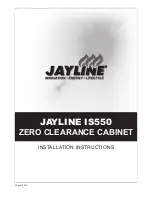
Page 5
H42DF-O Outdoor Gas Fireplace
Part No. XG0149
Installation
Vent Installation
This section covers the installation of direct venting and terminations.
Installation Requirements
■
H42DF-O fireplace are certified for use with Montigo Standard Series
(5" /
8")
venting components.
■
Minimum
clearance to combustible construction around the vent pipe
is 1"
on all sides, except on horizontal venting where the
top
of the pipe
must have a clearance of at least 2".
■
Use only
certified Montigo vent components.
(Use of other parts will void
the Montigo warranty, and may impede the operation of the fireplace.)
■
All joints must be secured with a minimum of two screws per joint
■
Vent terminations must not be recessed in walls or siding
■
Horizontal runs must be supported by a minimum of two supports per horizontal
run. A minimum of one screw on each side of support is also required
■
Flex vent sections may be stretched up to 50% of their total length (eg. a
24" section may be stretched to 36")
■
Maximum horizontal run with no vertical rise is 6 feet.
■
Flex vent sections over 6 feet must fall within the limits set by the venting
graph and must have a minimum vertical rise of 3 inches per foot of flex.
■
Solid vent sections may be cut less than half way from the female end
■
Venting components can be used in any combination of solid/rigid pipe or flex
pipe and in any orientation (Male connectors can face in any direction)
Vent Terminations
Selecting A Termination Location
Choosing your vent termination location will help to determine whether
you need to use a top vent or rear vent fireplace. Figure 6a, below, shows
typical fireplace locations and the venting options they provide.
For a more detailed diagram of allowed termination locations, see
Ap-
pendix A
.
Figure 6a.
Fireplace locations and vent terminations.
Installing The Gas Line
The gas line must be installed before finishing the H42DF-O Fireplace.
Natural Gas
requires a minimum inlet gas supply pressure of 5.5" W.C.
& a manifold pressure of 3.5" W.C.
Propane Gas
requires a minimum
inlet gas supply pressure of 11" W.C. & a manifold pressure of 10" W.C.
Provision must also be made for a 1/8" N.P.T. plugged tapping and be
accessible for test gauge connection immediately upstream of the gas
supply controls to the appliance. The fireplace gas connection and
the main operating gas valve is located behind the removable trim at
the bottom of the unit and need only be attached to the gas line with
an approved fitting, as required by the
applicable installation codes
.
To access the fireplace gas connection the main burner must be
removed as shown below in figure 5b.
• Only use gas shut-off valves approved for use by the state, province,
region, or governing body, in which the appliance is being installed, or
as required by the applicable installation codes.
• Flexible gas connectors must not exceed 3 feet in length, unless it is
allowable within applicable installation codes.
Note:
After gas line is connected,
each
appliance connection
,
valve and valve train
must be checked while under normal
operating pressure with either a liquid solution, or leak
detection device, to locate any source of leak. Tighten any
areas where bubbling appears or leak is detected until
bubbling stops completely or leak is no longer detected.
DO NOT use a flame of any kind to test for leaks.
Figure 5a.
Gas line access.
The appliance and its individual shut-off valve must be disconnected
from the gas supply piping system during any pressure testing of that
system at test pressures in excess of 1/2 psig (3.5 kPa).
The appliance must be isolated from the gas supply piping system by
closing its individual manual shut-off valve during any pressure testing
of the gas supply piping system at test pressures equal to or less than
1/2 psig (3.5 kPa).
Burner Tray Gasket
Figure 5b.
Gas line access.
Gasline Acces
0.875 dia.
7
to center
2
CAUTION!
Due to its high operating temperatures, the appliance
should be located out of traffic & away from furniture and
draperies.
Children and adults should be alerted to the hazards
of the high surface temperature, which could cause
burns or clothing ignition.
Young children should be carefully supervised when
they are in the same room as the appliance.
Clothing or other flammable materials should not be
placed on or near the appliance.






































